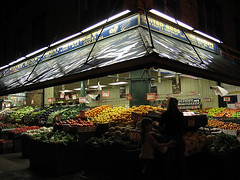Letter to the editor of the Washington Business Journal on urban supermarkets
Last week, the On Site magazine supplement of the Washington Business Journal had a piece about how great the local supermarket chains are at integrating their big stores into the urban fabric ("Changing demographics usher in a new golden age for D.C. supermarkets").
While it is great that these companies are opening new stores in the center city, for the most part they aren't doing it much differently than how they do stores in the suburbs. So I wrote a letter about it, which the WBJ ran, "Urban Safeway design misses the mark."
They were kind enough to unlock the story--normally letters to the editor are not part of the content they normally make available to non-subscribers (and hey, we should all subscribe now, shouldn't we?)--for the blogosphere and especially the readers of this blog.
This is paragraph 2:
I have been critical for years about how supermarkets, especially in D.C., are reintegrated into the urban fabric. It’s not just about the size of the facility, it’s also about how the supermarket connects to the street and extends the quality of the urban experience, by bringing the store outside and the street inside. (Think about the excitement of the crowds walking on M Street NW in Georgetown and how to continue that experience inside the store.)
They did add a word in one paragraph which changes the meaning, but you probably won't notice:
The grocery retailers in D.C. design and merchandise their stores for the most part just like their suburban counterparts, making proximity the only factor with some power for differentiation.
The second word, grocery, should be excised. I was referring to all retailers, not just supermarkets. That then makes the comparison of Carytown, Hampden in Baltimore, and Downtown Frederick more relevant.

Produce at Night, Astoria, Queens. Flickr photo by Joey in Vermont.
Labels: commercial district revitalization, supermarkets-groceries, urban design/placemaking, urban revitalization



0 Comments:
Post a Comment
<< Home